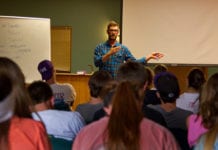By Mario Vega
Around two million Salvadorans live outside the country, mainly in the United States of America. Many left the country because of the civil war, while others fled the country due to the unemployment situation. Salvadorans who live abroad experience nostalgia for the country they left when they find themselves out of their homeland. This is called by Salvadorans in the Diaspora “homesickness for their own country.”
This “homesickness” drives the Salvadorans to meet in cells and share common memories, expressions, etc.. This is how the cells have been multiplying and then becoming a branch church of Elim El Salvador.
More than forty-four branch churhces have developed this way in the United States alone. And this number continues to steadily expand. These churches were not planted as a result of a strategic plan or even the sending of missionaries. These were churches that emerged spontaneously. The trigger element of this phenomenon is the training that those Salvadoran Christians had at Elim. As cell leaders, they learned by practice about the priesthood of all believers. For them, to find themselves in another country does not annul their Christian responsibilities.
This is probably a church planting model that responds more to the passion for evangelism and the action of the Holy Spirit, than any other element. At the same time, this confirms the truth of equipping the saints for the work of the ministry and releasing them to exercise the priesthood of all believers.
Comments?
Mario
Translation into Spanish:
Sacerdotes en tierra extranjera.
Alrededor de dos millones de salvadoreños viven fuera del territorio nacional, principalmente en los Estados Unidos de América. Una parte de ellos salieron del país por causa de la guerra civil, otros para huir de la situación de desempleo del país. Al encontrarse fuera de su tierra, los salvadoreños experimentan nostalgia por el país que dejaron. A eso, los salvadoreños en la diáspora le llaman ‘mal de país.’
Esa condición, es el caldo de cultivo sobre el cual el trabajo celular se desarrolla de manera efectiva. En la células, los salvadoreños se reencuentran a otros compatriotas, reencuentran las memorias, las expresiones, etc. Es así como las células se han ido multiplicando y, posteriormente, convirtiéndose en filiales de Elim en El Salvador.
Un poco más de 44 filiales se han establecido de esa manera en los Estados Unidos. Y ese número continúa en constante expansión. Esas iglesias no fueron plantadas como resultado de un plan estratégico o el envío de misioneros. Fueron iglesias que surgieron de manera espontánea. El elemento activador de ese fenómeno es el entrenamiento que esos cristianos salvadoreños tuvieron en Elim. Como líderes de células, aprendieron sobre el sacerdocio de todos los creyentes en la práctica. Para ellos, el encontrarse en otro país, no anula sus responsabilidades cristianas.
Probablemente, este sea un modelo de plantación de iglesias que responde más a la pasión por la evangelización y a la acción del Espíritu Santo que cualquier otro elemento. A la vez, esto confirma la verdad de capacitar a los santos para la obra del ministerio y liberarlos para ejercitar el sacerdocio de todos los creyentes.










